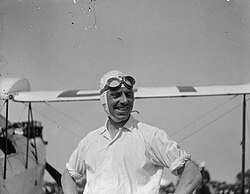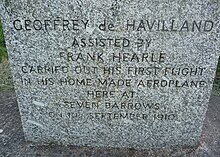Geoffrey de Havilland
Sir Geoffrey de Havilland (born July 27, 1882 in Haslemere , Surrey , † May 21, 1965 in Watford ) was a British aviation pioneer and designer .


Life
Geoffrey de Havilland was a cousin of Walter Augustus de Havilland , father of actresses Olivia de Havilland and Joan Fontaine . After graduating from engineering school, de Havilland was initially interested in building cars and motorcycles. After his marriage to Louise in 1907 and a gift of 1,000 pounds from his grandfather, he devoted himself to developing, building and flying airplanes until his death .
His first design, which he began in 1908 and built along with his wife and Frank Hearle, was in December 1909 when its first flight in Seven Barrows near Litchfield ( Hampshire destroyed). He ultimately taught himself to fly through trial and error and was a student of Hilda Hewlett at her Brooklands flight school. His second design, the FE1 , was successful and was bought by the British War Department.
He initially worked at the HM Balloon Factory (later known as the Royal Aircraft Factory ) in Farnborough , where he created the British Air Force's standard aircraft at the start of the First World War , the BE2 . He switched to Airco in 1914 , where he designed successful front-line aircraft such as the Airco DH.2 or the Airco DH.4 . He himself became the chief test pilot and flew in all new models himself. After the war, he took over Airco in 1920 and renamed it De Havilland Aircraft Company .
In the 1920s, some of his designs, such as the de Havilland DH.71 Tiger Moth , set several world records. The Moth series became world famous and countless pilots around the world have learned to fly with it; quite a few of these machines still fly today.
During the Second World War , the de Havilland DH.98 Mosquito became particularly famous. Because of his achievements and merits, de Havilland was beaten in 1944 to Knight Bachelor ("Sir").
Two of his three sons were killed by plane crashes in the De Havilland Aircraft Company during this period, the first, John, on a test flight in a Mosquito during the war in 1944, the second, Geoffrey de Havilland Junior , in a De Havilland DH in 1946 .108 Swallow trying to be the first pilot to break the sound barrier. His first wife Louise died of cancer shortly afterwards, and de Havilland remarried in 1951.
In the early 1950s, de Havilland brought out the world's first jet-powered airliner - the Comet . The first aircraft of this type crashed for an initially unexplained cause, which is why the operation of these aircraft was prohibited. After material fatigue in the pressurized cabin was finally identified as the cause, improved successor models could no longer be sold.
After the disaster with the Comet, de Havilland's company was taken over by Hawker Siddeley in 1959 . Sir Geoffrey de Havilland had been the company's boss until then. Havilland Point , a headland in Antarctica, bears his name in his honor.
literature
- Kurt W. Streit, John WR Taylor: History of Aviation. Künzelsau: Sigloch Service Edition, 1975, first London: New English Library, 1972 (with list of picture sources and detailed index; especially the chapter Great Constructors and their Work: Geoffrey de Havilland , pp. 322–327: with a portrait photo of Sir Geoffrey de Havilland and illustrations and descriptions of the types of aircraft he developed).
Web links
Individual evidence
- ↑ Kenneth Aitken: Geoffrey de Havilland (Fathers of British Aviation No. 4) , in Airplane Monthly, June 1993, p. 16
| personal data | |
|---|---|
| SURNAME | Havilland, Geoffrey de |
| BRIEF DESCRIPTION | English aviation pioneer and designer |
| DATE OF BIRTH | July 27, 1882 |
| PLACE OF BIRTH | Haslemere , Surrey |
| DATE OF DEATH | May 21, 1965 |
| Place of death | Watford , Hertfordshire |